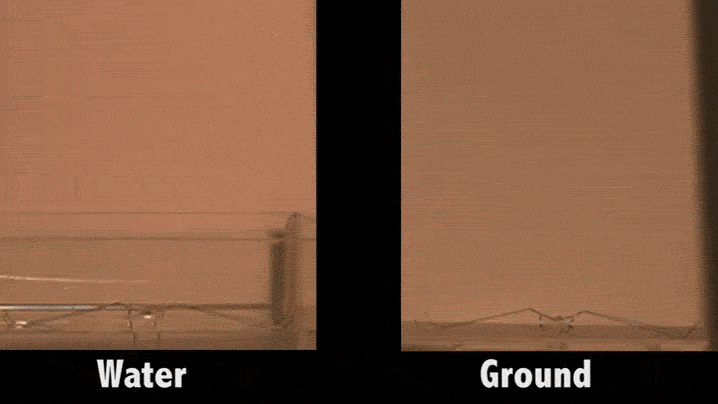Taking inspiration from nature, scientists in South Korea hijacked millions of years of evolution and devised their very own robotic version of a water-strider – insects that can jump on water. Their tiny droid mimics the water-strider in both its water balancing acts and jumping on water, which is a lot harder than it sounds.
Je-Sung Koh, at Seoul National University in South Korea, and colleagues first used high speed cameras to carefully study the gait and motion of water-striders on water. Koh found that the insects have a specialized feet coated with a hydrophobic substance that helps them float on the surface of the water without actually sinking in it one bit. As far as jumping on water is concerned, though, the insects employ a physical mechanism, carefully coordinating its legs to steadily build momentum for the leap all while never breaking surface tension.
Surface tension is a phenomenon in which the surface of a liquid, where the liquid is in contact with gas, acts like a thin elastic sheet. This term is typically used only when the liquid surface is in contact with gas (such as the air). Water has one of the most strongest surface tension since water molecules are linked with one another by a hydrogen bond. Besides the hydrophobic coating, the surface of a water strider’s legs distribute its weight, causing the surface of the liquid to become depressed, minimizing the potential energy to create a balance of forces so that the strider can move across the surface of the water without breaking through the surface. This is similar in concept to wearing snow shoes to walk across deep snowdrifts without your feet sinking.
The tiny bot developed at Seoul weighs only 68 milligrams and measures 160 mm in length. Its four legs are coated with a superhydrophobic material and are held together with a tiny body and a spring. When a zap of heat hits the bot, the heat-reactant spring releases causing the curved legs to move inward. Then it accelerates with 14g to jump to the height of 14 cm.
“Normally, jumping requires a large force to be applied to the surface that you are jumping on,” the researchers say. “[But when jumping] on water, legs will easily penetrate the water, and even if you can jump on water, the jumping height will [usually] be lower than jumping on ground. However, our small robot can jump on water without breaking the water surface, and can jump on water as high as jumping on land.”
The strider-bot isn’t quite perfect though. Unlike the real water strider, the robot sinks in the water after it lands from its jump. But it’s definitely a interesting demonstration. It’s small leaps such as these that will eventually make robots feel at home on any terrain, be it in landfills, Mars’ rugged terrain or on water.










